Investment markets and key developments
Following a bad start to the week on worries about a US recession made worse by investors rushing to unwind risky positions in response including Yen carry trades, shares then clawed back their losses helped by better-than-expected US economic data and comments from the Bank of Japan that it will not raise rates in “unstable markets.” This left Eurozone shares up 0.6% for the week, US shares flat (or -0.04% to be precise), but Japanese shares down 2.5% and Chinese shares down 1.6%. Similarly, Australian shares managed to recover some of their loses from the 3.7% panic sell off on Monday but still fell 2.1% for the week. Bond yields rebounded as safe haven demand was unwound and expectations for emergency central bank rate cuts were wound back, with the exception being Japanese bond yields which fell on the back of dovish BoJ comments. Oil prices rose on uncertainty around escalating Israel/Iran tensions, but copper and iron ore prices fell on concerns about global growth. The $A rose, with a slight fall in the $US.
Shares could bounce a bit further but remain at high risk of further falls over the next few months. From their recent highs to their lows US and global shares had roughly 9% falls and nearly 6% for Australian shares. While it was dramatic such falls are not unusual in an historic context. Of course, shares rarely go in a straight line so after the falls left them oversold they have had a bounce helped by some better-than-expected US economic data and dovish BoJ comments. The bounce could run a bit further, particularly as US economic data beyond the rise in unemployment is still not indicating that a recession is upon us. Its also a bit confusing as the triggering of the Sahm Rule was due to a surge in the supply of workers not lots of layoffs and may have been impacted by Hurricane Beryl. And US and global profits have been strong in the June quarter at around +10%yoy. Similarly in Australia economic data is still not yet consistent with a recession. However, shares remain vulnerable to further falls over the next few months as: valuations remain stretched; investment sentiment is not yet at levels that signal major market bottoms; recession risk is very high in the US and Australia with forward looking jobs indicators pointing down and markets are not priced for this; and geopolitical risk is high particularly around the US election and the Middle East (with a high risk of escalation between Iran and Israel after the assassination of Hamas’ leader in Iran); and we have only just started in the seasonally weak period of August and September which can sometimes extend into October/November in US election years. The last two weeks provide an indication of how sensitive investors are to weaker economic data at present.
The RBA left rates on hold but is surprisingly hawkish and guiding against a rate cut this year. While the RBA reiterated that its “not ruling anything in or out”, it now sees slightly more excess demand in the economy, it revised up its growth forecasts and now sees a slightly slower return of underlying inflation to target, it gave “very serious consideration” to another hike but not a cut and Governor Bullock noted that “interest rate reductions by the end of the year and the next six months…doesn’t align with the [Board’s] thinking…at the moment”. Governor Bullock added later in the week that it “will not hesitate” to hike again if inflation remains persistently high. This hawkishness was a bit surprising given that in the last few months economic growth came in weaker than expected and inflation was broadly in line with RBA forecasts, the RBA’s near-term wage growth forecasts have been revised down and uncertainty regarding growth in China and the US has increased.
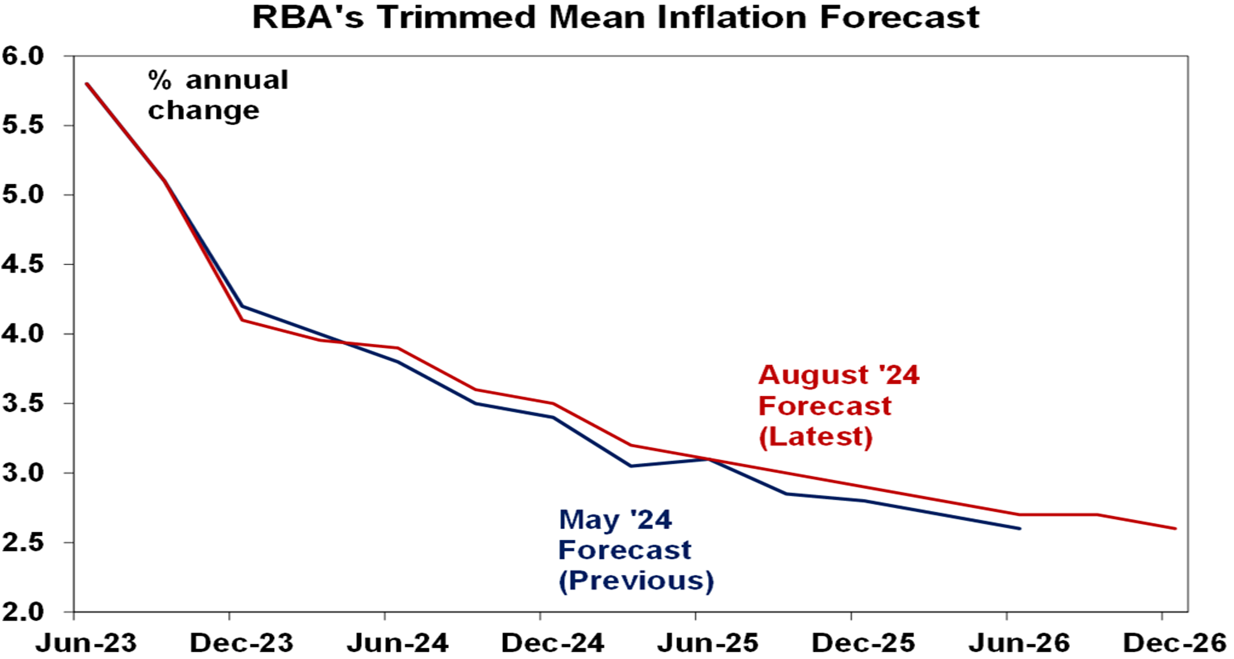
Source: ABS, RBA, AMP
Seven reasons why rates have peaked, and the next move is down. Given the RBA’s hawkish tilt another rate hike still can’t be ruled out but in the absence of the inflation staying higher than expected we see it as a low probability at around 10% and continue to see rates as having peaked with the next move being down. Here’s seven reasons why.
1. Monetary policy remains restrictive.
2. The full impact of past rate hikes is still feeding through.
3. Recession risks are high as indicated by the ongoing slump in real household spending per capita – the tax cut boost will be largely offset by households looking to support their depressed saving rate and a roughly 1 percentage point reduction in population growth. Meanwhile the outlook for home building and business investment looks soft.
4. Forward looking jobs indicators warn of a significant further rise in unemployment ahead.
5. Wages growth has peaked which will slow underlying services inflation.
6. Allowing for Australia lagging the inflation cycle in the US and other comparable countries indicates that Australia is not that different in terms of getting inflation down and will likely see a resumption of falling underlying inflation in the months ahead.
7. Finally, the downside risks around the US and Chinese economies have increased.
We expect the first cut in February, but despite RBA guidance it could still come late this year if economic data and or share markets weaken sharply. Our base case is that in the absence of a negative shock it will likely take more than one good quarterly CPI release to see the RBA get “confident that inflation is moving sustainably towards the target” and so it will likely wait for the December quarter CPI release in late January before starting to cut in February. However, the Governor’s guidance of ‘no rate cut before year end’ is not iron clad. The 2021-22 experience with ‘no rate hike before 2024’ RBA guidance highlights that the RBA can get it wrong. The RBA’s guidance is contingent on current forecasts with the reference to the Board’s thinking “at the moment” and that thinking could change quickly. In this regard the RBA will likely be forced to cut earlier and quicker if it has to change its forecasts in the event of much weaker economic conditions and or a sharp fall in share markets. In terms of what the RBA should do as opposed to what we think it will do, given the US experience it should now be starting to give consideration to a cut in interest rates as it now risks much higher unemployment and inflation falling below target. The money market doesn’t always get it right either and it bounces around a lot. It was premature in expecting cuts earlier this year, but it was right in early 2022 in anticipating imminent rate hikes despite the RBA pushing back against it. Right now, it’s still fully pricing in a rate cut by year end despite the RBA’s guidance.
There’s lots of comments around that the RBA can’t not follow the Fed and other central banks. But historically this has not been the case as when different economic conditions justify it the RBA has diverged (eg hiking in 2009 when the Fed was holding, and holding and cutting through 2015-2018 when the Fed was hiking). That said, we do think it will ultimately follow the Fed and other central banks because our economy and inflation cycle is similar with Australia following with a three-month or so lag.

Source: Bloomberg, AMP
Strong public spending is making the RBA’s job harder. On the one hand the Federal Government argues that its been running a budget surplus (of $22bn in 2022-23 and something similar in 2023-24) and this helps take pressure off inflation because it means the Government is taking more out of the economy than it puts in. This is true. But the surplus has been achieved because of windfall tax revenue on the back of more jobs driving more personal tax payments and higher than expected commodity prices resulting in bigger company tax payments from miners. This is the so-called “automatic stabilisers” at work. However, it only covers part of the story because Government decisions have actually eased fiscal policy. In the October 2022-23 Budget this was modest with only 14% of the windfall being spent but in this year’s May Budget nearly double the windfall was projected to be spent. This along with state government spending decisions has shown up in progressively higher growth in public final demand. For example in the February 2023 RBA Statement on Monetary Policy public demand was forecast to rise 1.7% over the year to June 2024 and 1.6% over the year to June 2025, whereas in the latest SOMP those forecasts have more than doubled to 4% and 4.1% respectively. This is resulting in record levels of public spending in the economy (see the next chart) and adds to total demand in the economy which makes it harder for the RBA to reduce the level of demand relatively to supply in order to reduce inflation. Hence the RBA’s comment that its latest underlying inflation forecasts show “a slightly slower return to target than forecast in May and is due to greater inflationary pressures in the economy. In part, this owes to a stronger outlook for domestic demand, led by higher public demand and a recovery in household consumption.” I am not so sure about the recovery in household consumption but there is no doubt that stronger public demand means stronger demand in the economy which means higher than otherwise inflationary pressures. So were it not for the constant upgrades in public spending inflationary pressures would likely to be lower, and may even have allowed the RBA to be cutting rates by now or be close to it.
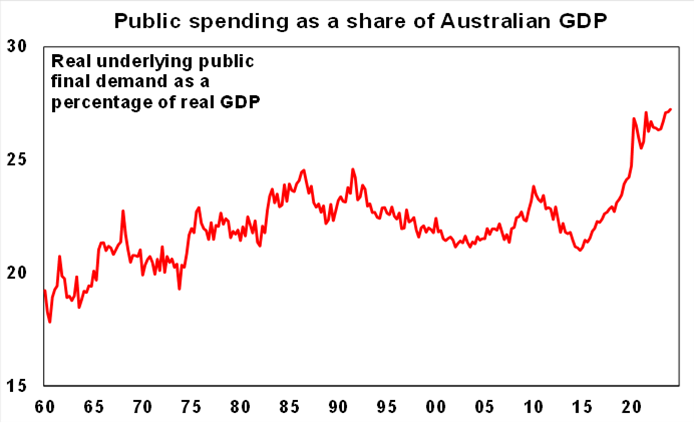
Note that this excludes transfer payments like welfare. Source: ABS, AMP
On the economic policy front the Federal Government’s move to fund a 15% pay rise for childcare workers on condition their employers limit any fee increase to 4.4% for the next 12 months is a mixed bag. On the one hand its good for childcare workers and limits fee increases to 4.4%. But it runs the risk of adding to wages growth in the care and hospitality sector just as a similar sized increase in aged care wages helped fuel the claim for childcare workers. This risks further adding to inflation in the services sector and delaying rate cuts. That said on its own it likely adds only 0.1% to wages growth and the ability to win big pay rises in hospitality may be fading as discretionary spending weakens.
More big government. The Queensland Government’s election campaign decision to open government owned petrol stations and cap fuel price rises is a real concern. Reverting to old fashioned public ownership and price caps to get prices down is just a gimmick. Public ownership and price caps have both been tried over and over in the past and ultimately just make things worse by discouraging supply and limiting price falls and are a poor use of taxpayer money. We should be relying more on the ACCC and making things easier for independent petrol retailers.
Democrat prospects have improved with Harris confirmed as the Democrats’ candidate and Tim Walz as running mate. Harris now leads in the average polls and favourability, she has cut Trump’s lead in the battleground states and she leads in two of them and a Harris/Democrat victory is now seen as around 57% probable by betting markets. Trump may have peaked early, but Harris and Walz may be seeing a honeymoon effect and they are still behind where Biden was in 2020. Weaker economic conditions won’t help Harris but its doubtful any downturn will come quickly enough to have a big impact. So there is still a high risk that at some point markets will start to become more concerned again about Trump policies which point to higher inflation.
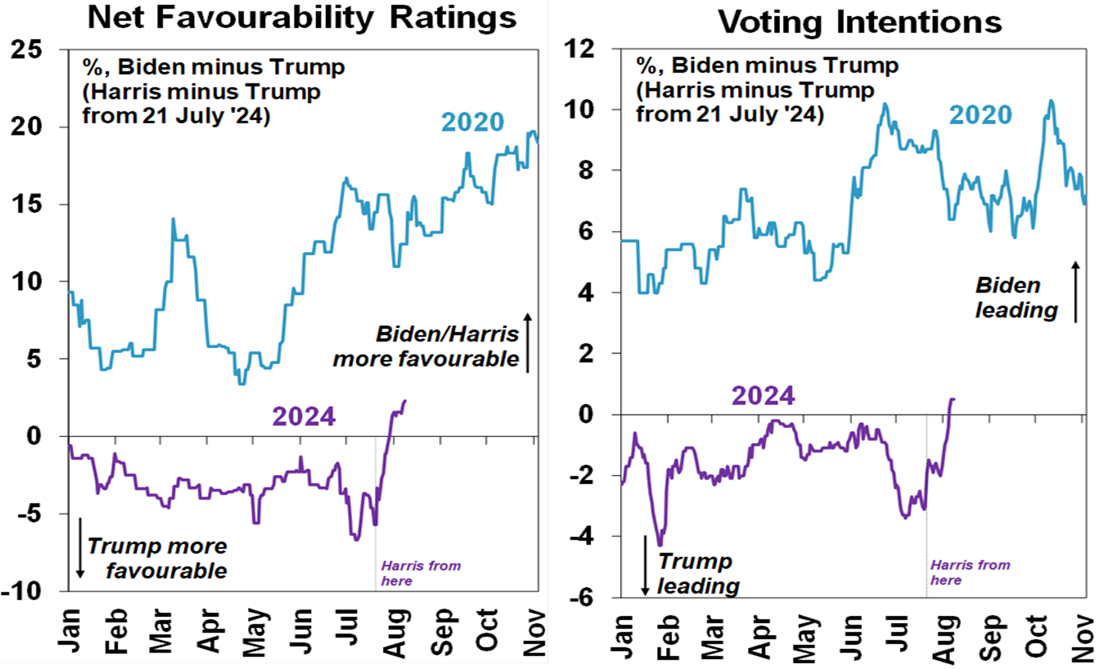
Source: PredictIt, AMP
Australia’s best Olympics. In terms of gold medals we are in the top three countries. Adjusting for population size and GDP we are far surpassing the US and China. Of course I am only comparing to the top 10 countries here! Will there be a boost to the Aussie economy apart from a brief feel good moment? I doubt it!
Top 10 Olympic Medal Winning Countries
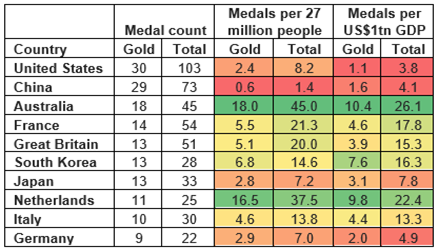
Source: AMP
Major global economic events and implications
It was a quiet but more positive week for US economic data. The July services conditions ISM improved, including for employment, contrasting with weakness in the manufacturing ISM. And initial jobless claims fell with the impact of Hurricane Beryl unwinding. However, the trend remains up. Both helped ease fears of a rapid deterioration in the US economy though.
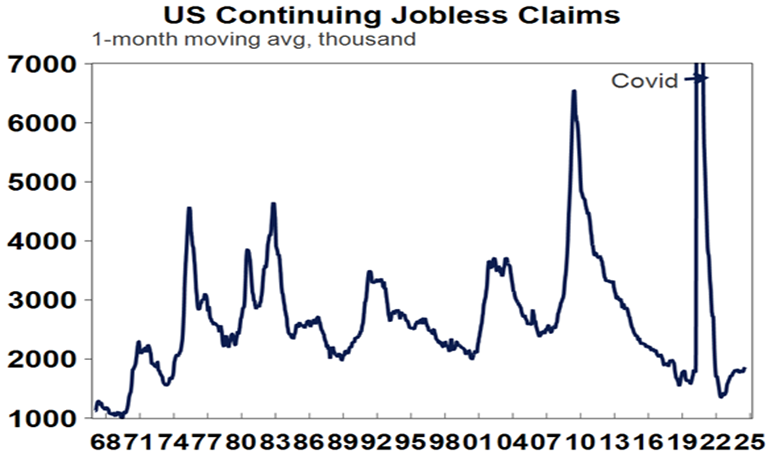
Source: Macrobond, AMP
Meanwhile, the Fed’s latest bank lending survey showed a further easing in the pace at which lending standards are being tightened after the spike last year around problems in regional banks. However, banks also reported either slower or unchanged demand for loans.

Source: Bloomberg, AMP
91% of US S&P 500 companies have reported June quarter earnings. The results are good but have been more mixed from tech stocks and some consumer discretionary sectors, like travel, are looking softer. 78.6% of companies have beat earnings expectations which is above the norm of 76% but below the experience of the last reporting season. Consensus expectations for earnings growth are now 11%yoy, up from 7.8% at the start of the reporting season. Ex tech earnings are up 5%yoy.

Source: Bloomberg, AMP
Eurozone retail sales & German factory orders were weak in June.
Canadian wages rose 5.2%yoy in July, but employment fell and unemployment held at 6.4%.
Unemployment up in New Zealand to 4.6% in the June quarter. Employment rose but hours worked fell 1%. Wages growth remained little changed at 4.3%yoy. Overall, this was in line with market and RBNZ expectations.
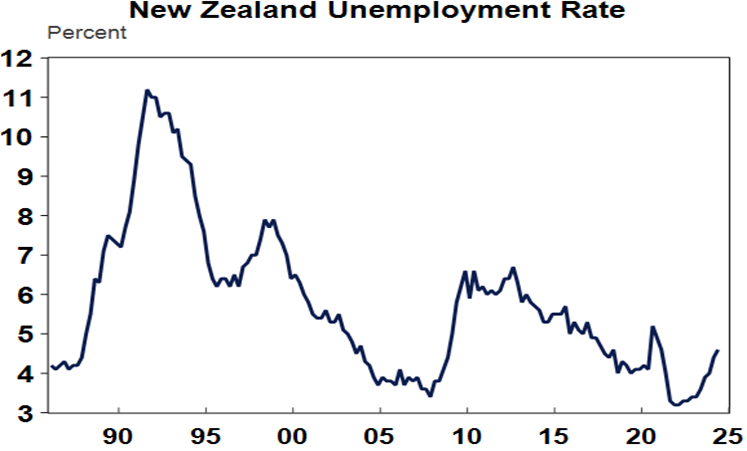
Source: Macrobond, AMP
Chinese economic data was mixed. The Caixin services conditions PMI surprisingly rose in contrast to the official services PMI, but the overall business conditions remain weak. Chinese trade data was mixed with exports slowing but imports bouncing higher. Inflation in July rose slightly with higher food prices but only to 0.5%yoy with core inflation falling to 0.4%yoy.
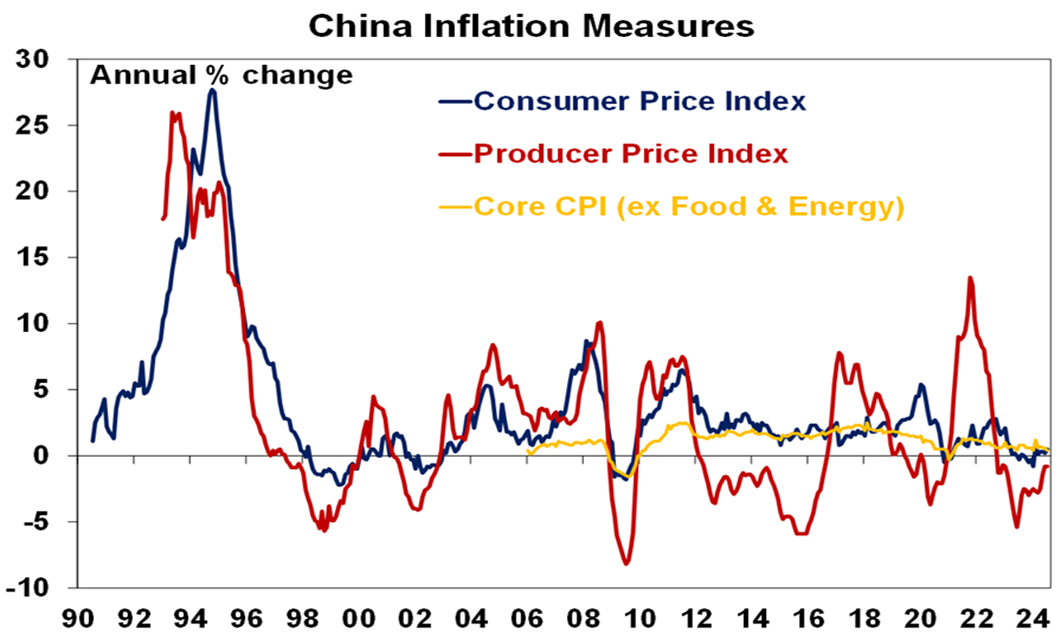
Source: Bloomberg, AMP
Australian economic events and implications
It was a light week for Australian data. However, three things stood out. Firstly, the Melbourne Institute’s Inflation Gauge slowed again pointing to a resumption of the downtrend in inflation.

Source: ABS, AMP
Secondly, ANZ job ads fell 3% in July and are down 20.8% on a year ago pointing to slowing jobs growth & rising unemployment.
Finally, profit updates and results from Myer and Nick Scali are consistent with consumers struggling.
What to watch over the next week?
In the US, it will be back to focussing on inflation with July CPI data (Wednesday) expected to show a 0.2%mom rise bringing annual inflation down to 2.9%yoy. Core inflation of 0.2%mom is also expected bringing its annual rate down to 3.2%yoy from 3.3%yoy. In other data expect continued soft small business optimism (Tuesday), a slowing in underlying retail sales growth, flat industrial production and still weak manufacturing conditions in the New York and Philadelphia regions (all Thursday) and flat housing starts (Friday).
Japanese June quarter GDP growth (Thursday) is expected to bounce back to 0.6% from a 0.7% contraction in the March quarter with growth in both consumer and business spending.
The Reserve Bank of New Zealand (Wednesday) is likely to cut its policy rate to 5.25%, with the money market ascribing a 74% probability.
Chinese economic activity data for July (Thursday) is expected to show ongoing softish conditions with a slight improvement in industrial production to 5.4%yoy and retail sales to 2.6%yoy, unchanged growth in investment at 3.9%yoy along with continuing weak property related indicators.
In Australia, June quarter wages growth (Tuesday) is expected to be 0.8%qoq with annual growth slowing to 3.9%yoy from 4.1%yoy consistent with expectations that wages growth has peaked. The Westpac consumer survey for August is likely to show continuing weak consumer confidence and the July NAB survey is likely to show a further slowing in business conditions (also both due Tuesday). July jobs data is expected to show a 15,000 gain in employment with unemployment unchanged at 4.1%.
The Australian June half profit reporting season will start to ramp up with 32 major companies reporting including JB HiFI (Monday), CSL and Seek (Tuesday), AGL, CBA and Seven (Wednesday), Origin, Cochlear and Telstra (Thursday) and the ASX (Friday). Consensus expectations are for a 3.6% fall in earnings for 2023-24 driven by a sharp fall in energy sector profits with miners, banks and consumer staples also expected to be down but with strong gains in profits for utilities, health care and industrials. Key to watch will be guidance around how the consumer is holding up with high interest rates and cost of living pressures along with indications around input cost pressures and pricing power. It’s a bit of a make or break earnings season in terms of guidance because after two years of earnings falls they are expected to rebound to 4.8% growth this financial year.
Outlook for investment markets
Easing inflation pressures, central banks moving to cut rates and prospects for stronger growth in 2025-26 should make for reasonable investment returns over 2024-25. However, with a high risk of recession, poor valuations and significant geopolitical risks particularly around the US election, the next 12 months are likely to be more constrained and rougher compared to 2023-24 and there is a high risk of a further correction in the next few months.
A recession is the main threat for shares and there is a risk that we may have already seen the high for the year in the Australian share market after it reached our year-end target of 8100 in early August.
Bonds are likely to provide returns around running yield or a bit more, as inflation slows, and central banks cut rates.
Unlisted commercial property returns are likely to remain negative due to the lagged impact of high bond yields and working from home.
Australian home prices are likely to see more constrained gains over the next 12 months as the supply shortfall remains, but still high interest rates constrain demand and unemployment rises. The delay in rate cuts and talk of rate hikes risks renewed falls in property prices as its likely to cause buyers to hold back and distressed listings to rise.
Cash and bank deposits are expected to provide returns of over 4%, reflecting the back up in interest rates.
A rising trend in the $A is likely taking it to $US0.70 over the next 12 months, due to a fall in the overvalued $US and a narrowing in the interest rate differential between the Fed and the RBA. A recession is the main downside risk.

Weekly market update 22-11-2024
22 November 2024 | Blog Against a backdrop of geopolitical risk and noise, high valuations for shares and an eroding equity risk premium, there is positive momentum underpinning sharemarkets for now including the “goldilocks” economic backdrop, the global bank central cutting cycle, positive earnings growth and expectations of US fiscal spending. Read more
Oliver's insights - Trump challenges and constraints
19 November 2024 | Blog Why investors should expect a somewhat rougher ride, but it may not be as bad as feared with Donald Trump's US election victory. Read more
Econosights - strong employment against weak GDP growth
18 November 2024 | Blog The persistent strength in the Australian labour market has occurred against a backdrop of poor GDP growth, which is unusual. We go through this issue in this edition of Econosights. Read moreWhat you need to know
While every care has been taken in the preparation of this article, neither National Mutual Funds Management Ltd (ABN 32 006 787 720, AFSL 234652) (NMFM), AMP Limited ABN 49 079 354 519 nor any other member of the AMP Group (AMP) makes any representations or warranties as to the accuracy or completeness of any statement in it including, without limitation, any forecasts. Past performance is not a reliable indicator of future performance. This document has been prepared for the purpose of providing general information, without taking account of any particular investor’s objectives, financial situation or needs. An investor should, before making any investment decisions, consider the appropriateness of the information in this document, and seek professional advice, having regard to the investor’s objectives, financial situation and needs. This article is solely for the use of the party to whom it is provided and must not be provided to any other person or entity without the express written consent AMP. This article is not intended for distribution or use in any jurisdiction where it would be contrary to applicable laws, regulations or directives and does not constitute a recommendation, offer, solicitation or invitation to invest.
The information on this page was current on the date the page was published. For up-to-date information, we refer you to the relevant product disclosure statement, target market determination and product updates available at amp.com.au.

